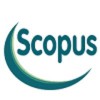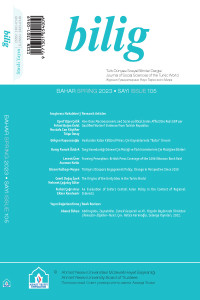Research Article
Aim & Scope
bilig aims to present the cultural riches as well as the historical and contemporary realities of the Turkic world within a scientific framework. It also aims to inform the public of scientific studies of international quality focusing on the Turkic World.
bilig publishes articles that approach the current and historical problems of the Turkic world from a scientific perspective and propose solutions to these issues.
Author Guidelines
Ethical Principles and Publication Policy
bilig follows the documents "Code of Conduct and Best Practice Guidelines for Journal Editors" and "Code of Conduct for Journal Publishers" of the Publication Ethics Committee (COPE). Regarding the "Core Practices" document of COPE, see. https://publicationethics.org
Authors submitting their work to bilig are obliged to meet the ethical principles stated below:
Authorship of the paper: Authorship should be limited to those who have made a significant contribution to the study. Authorship has been agreed prior to submission and that no one has been ‘gifted’ authorship or denied credit as an author (“ghost authorship”).
Acknowledgements: Those (institutions and financial resources) who have provided support but have not contributed to the research should be acknowledged in an Acknowledgements section.
Originality and purity of plagiarism: The submitted work should be entirely owned by the authors. If the work of other researchers is included in the manuscript, it should be cited appropriately and listed in the references. The author is obliged to check the manuscript with one of the plagiarism prevention software, Turnit-in or iThenticate, and submit the similarity report to the journal for application. Manuscripts with a similarity rate of 15% or more will not be considered.
Ethics committee permission and approval: Authors are required to describe in their manuscripts ethical approval from an appropriate committee and how consent was obtained from participants when research involves human participants.
Redundant publication: Authors are expected to submit original, previously unpublished content to bilig. It is unacceptable to submit the work for a review to another journal at the same time.
Salami publication or salami slicing: Authors should not present the results of a research as separate publications in academic appointments and promotions by disaggregating and disseminating the results of the research in an inappropriate manner and disrupting the integrity of the research.
Data access and retention: Authors are required to submit the raw data of their research when requested by the editors and referees, and keep this data after publication.
Fundamental errors in published works: When an author discovers a significant error or inaccuracy in his/her own published article, it is the author's obligation to promptly notify the journal editor and cooperate with the editor to retract or correct the paper.
Price Policy
bilig'de makale değerlendirme ve yayın aşamasında yazardan hiçbir şekilde ücret alınmaz. Yazara da telif ücreti ödenmez.
Indexes
Journal Boards
Editor
Editorial Board (Field Editors)

1. Family name: DJUMANIYAZOVA
2. First name: FERUZA
3. Second name: DJUMANAZAROVNA
4. Date of birth: 25 April 1984
5. Nationality: Uzbekistan
6. Passport: AA3429331
7. Date of issue: 26.11.2013
8. Martial status: Married in 2010
9. Education:
1. Institution Al-Biruni Institute of Oriental Studies of the Academy of Sciences of Uzbekistan, Tashkent
Date: from to January 2010 -
Name of the Thesis The Turkic dynasties in the Tokharistan and Kabul valley in the early Middle Ages
Degree or Diploma:
Obtained: Candidate of Historical Sciences, Tashkent (Doctor of Philosophy –Ph.D.)
30.08.2018.
№000719
Doçent: №002666 10.12.2019.
Specialization General History (07.00.03.)
2. Institution Tashkent State Pedagogical University named after Nizami
Date: from to September 2007 - June 2009
Name of the Thesis “The Ughuz Constituent in the Ethnic Formation of Uzbek Nation”
Degree or Diploma:
Obtained: Master’s Degree
Diploma М № 041918
date of Issue 25 july 2009
Specialization History
3. Institution Tashkent State Pedagogical University named after Nizami
Date: from to September 2003 - June 2007
Name of the Thesis “Ethnic processes in the Khiva Khanate”
Degree or Diploma:
Obtained: Bachelor Degree,
Diploma B № 022203 (With Honours),
date of Issue 19 july 2007
Specialization History
4. Institution The Abu Rayhan Biruni Institute of Oriental Studies, The Academy of Science of Republic of Uzbekistan
Date: from to April 2009 - June 2018
Name of the Thesis The Turkic Dynasties in Tokharistan and Kabul Valley in Early Middle Ages.
Degree or Diploma:
Obtained: PhD Degree,
Diploma B № 000719,
date of Issue 30 August 2018
Specialization History

Prof. Dr. Yüksel ÇELİK
1971 yılında İstanbul’da doğdu, 1994 yılında Marmara Üniversitesi Atatürk Eğitim Fakültesi Tarih Bölümü’nden mezun oldu. Bir yıl sonra araştırma görevlisi olarak yüksek lisans eğitimini aynı üniversitenin Türkiyat Araştırmaları Enstitüsü’nde, doktora eğitimini ise İstanbul Üniversitesi Sosyal Bilimler Enstitüsü’nde tamamladı. Doktora sürecinde kazandığı bursla İskoçya ve İngiltere’de alanıyla ilgili çalışmalar yaptı. 2011 yılında Yakınçağ Tarihi alanında doçent, 2017 yılında profesör unvanı aldı. 2019-21 yılları arasında Kazakistan’da Ahmet Yesevi Üniversitesi’nde öğretim üyesi ve Sosyal Bilimler Fakültesi dekanı olarak görev yaptı. 2007 yılında “Tanzimat Devrinde Rüşvet-Hediye İkilemi ve Bu Alandaki Yolsuzlukları Önleme Çabaları” başlıklı makalesi ile Osmanlı Bankası Arşiv Araştırma Merkezi ile Tarih Vakfı tarafından verilen European Association for Banking and Financial History (Avrupa Bankacılık ve Finans Tarihi Birliği) ödülüne, 2009 yılında Prof. Dr. Işın Demirkent Tarih Ödülü’ne, 2015 yılında Şeyhü’l-Vüzera Koca Hüsrev Paşa -II. Mahmud Devrinin Perde Arkası künyeli eseri ve 2023 yılında ise Rami Kışlası II. Mahmud Devrinde Aydın-Despotik Modernleşmenin Karargâhı künyeli eseriyle telif eser dalında iki kez Türkiye Bilimler Akademisi (TÜBA) ödülüne layık görülmüştür. Marmara Üniversitesi İnsan ve Toplum Bilimleri Fakültesi Tarih Bölümü’nde öğretim üyesi olarak görev yapan Yüksel Çelik’in, temel ilgi alanları olan Yakınçağ Osmanlı Tarihi, XIX. yüzyılda Osmanlı dünyasında bilim-sanat, mimarlık, modernleşme ve askeri reform tarihi konularında yayımlanmış çok sayıda çalışması mevcuttur.
Özgeçmiş ve Eğitim:
2019: Türk Tarih Kurumu “Bilim Kurulu” üyeliğine seçildi.
2013: H.Ü. Türkiyat Araştırmaları Enstitüsü’ne “Profesör” olarak atandı (14.08.2013).
2012: Türkiyat Araştırmaları Enstitüsü Müdürü oldu (25.01.2012).
2010: TKAE, Türk Kültürünü Araştırma Enstitüsü Yönetim Kurulu Üyeliğine seçildi.
2006: Tarih Bölümü'nde "Doçent" kadrosuna atandı (06.12.2006).
2006: "Osmanlı Kurumları ve Medeniyeti Tarihi" alanında "Doçent" unvanı aldı (08.05.2006).
2004: H.Ü. Türkiyat Araştırmaları Enstitüsü Müdür Yardımcılığı görevine atandı.
1998: İLESAM, Türkiye İlim ve Edebiyat Eseri Sahipleri Meslek Birliği Yönetim Kurulu Üyeliğine seçildi.
1998: Hacettepe Üniversitesi Edebiyat Fakültesi Tarih Bölümü'nde Yardımcı Doçent Kadrosuna atandı. Aynı yıl Tarih Bölümü Başkan Yardımcısı oldu.
1997: Paris I Üniversitesi’nde (Université de Paris I, Panthéon-Sorbonne) "çok iyi" derece ile "Tarihte Doktor" unvanı aldı (27.11.1997).
1995: Burs süresinin sona ermesi üzerine Fransa'dan dönerek Hacettepe Üniversitesi Tarih Bölümü'ndeki görevine başladı.
1993: Dil kurslarını takiben kayıt yaptırdığı Paris I Üniversitesi (Université de Paris I, Panthéon-Sorbonne) Bizans ve Bizans Sonrası Yakın Doğu Tarihi Araştırmaları Bölümü’nde DEA (Diplôme d'Etudes Approfondies) derecesi aldı.
1990: 1988 yılında başladığı Doktora eğitimini yarıda bırakarak Hacettepe Üniversitesi burslusu olarak "Dil ve Doktora" eğitimi amacıyla Fransa'ya gitti.
1988: H. Ü. Sosyal Bilimler Enstitüsü Tarih Anabilim Dalı'ndan "Tarihte Bilim Uzmanı" (MA) derecesi aldı.
1987: H. Ü. Edebiyat Fakültesi Tarih Bölümü'nde “araştırma görevlisi” olarak çalışmaya başladı.
1987: Türk Tarih Kurumu'nda “uzman yardımcısı” olarak çalıştı.
1985: H. Ü. Sosyal Bilimler Enstitüsü Tarih Anabilim Dalında Yüksek Lisans (MA) eğitimine başladı.
1985: Bir yıl İngilizce Hazırlık Sınıfı okuduktan sonra H.Ü. Edebiyat Fakültesi Tarih Bölümü'nden Lisans düzeyinde mezun oldu.
Yabancı Dil: Fransızca, İngilizce.
Akademik Çalışmalar:
I. Tezler :
Yüksek Lisans (Hacettepe Üniversitesi, Tarih Bölümü, Ankara):
Hicri 983 (1575-1576) Tarihli Mufassal Tahrir Defterine Göre Bozok Sancağında İskân ve Nüfus, H. Ü. Sosyal Bilimler Enstitüsü, Tarih Anabilim Dalı, Bilim Uzmanlığı (Master) Tezi, Ankara, 1988.
DEA: Diplôme d’Etudes Approfondies (Université de Paris I, Panthéon-Sorbonne, Fransa):
Les recueils de lois coutumières ottomanes: le manuscrit de Munich TURC 111, Paris I Universitesi (Université de Paris I Panthéon-Sorbonne), Histoire et Archéologie du monde byzantin et post-byzantin, Paris, 1993.
Doktora (Université de Paris I, Panthéon-Sorbonne, Fransa):
La fixation par écrit des lois ottomanes et le rôle des codes de lois. Etude accompagnée de l'édition du manuscrit de Munich Turc 111 (XVe-XVIe siècles). Paris I Üniversitesi (Université de Paris I Panthéon-Sorbonne), Paris, 1997.
II. Yayınlar:
a. Kitap:
1. Koç, Yunus, XV. Yüzyılda Bir Osmanlı Sancağı’nın İskân ve Nüfus Yapısı, Kültür Bakanlığı Yay., Ankara, 1989.
2. Koç, Yunus - Fatih Yeşil, Nizam-ı Cedit Kanunları, Türk Tarih Kurumu Yay., Ankara, 2012.
3. Koç, Yunus, Bozok 1575 -İskân ve Nüfus-, Ankara 2021, Net Kitaplık.
b. Kitap/Kitap Bölümü Editörlüğü:
1. Koç, Yunus, (Yayına Hazırlayan), Hilmi Ziya Ülken, Seçme Eserler I, Ziya Gökalp, İstanbul, 2007, Türkiye İş Bankası, Kültür Yay.
2. Koç, Yunus, (Serdar Sağlam, Cahit Gelekçi ile birlikte Yayına Hazırlayan), I. Türkiyat Araştırmaları Sempozyumu, 25-26 Mayıs 2006: Bildiriler, Ankara, 2006, H.Ü. Türkiyat Araştırmaları Enstitüsü Yay.
3. Koç, Yunus (Ü. Çelik Şavk, Mikail Cengiz ve Fatma Türkyılmaz'la birlikte Yayına Hazırlayan), Yaşayan Eski Türk İnançları Bilgi Şöleni, (17 Nisan 2007 H.Ü. Sıhhiye Yerleşkesi), Bildiriler, Ankara, 2007, H.Ü. Türkiyat Araştırmaları Enstitüsü Yay.
4. Koç, Yunus (Marcel Erdal ve Mikail Cengiz’le birlikte Yayına Hazırlayan), Dilleri ve Kültürleri Yok Olma Tehlikesine Maruz Türk Toplulukları: 4. Uluslararası Türkiyat Araştırmaları Sempozyumu (23-26 Mayıs 2012 Ankara) Bildirileri, Ankara, 2013, H. Ü. Türkiyat Araştırmaları Enstitüsü Yay.
5. Koç, Yunus, Antik Çağdan XXI. Yüzyıla Büyük İstanbul Tarihi, Siyaset ve Yönetim-2: Demografi, (Proje Yön.: M. Akif Aydın; Editör: Coşkun Yılmaz), ”Demografi”, Bölüm Editörlüğü, ( C. 3, İstanbul Büyükşehir Belediyesi Kültür A.Ş. Yay., İstanbul, 2015.
6. Koç, Yunus (Serhat Küçük’le birlikte) Editör, Türk Sosyal Tarihçiliğinde Bir “Yalnız” İsim: Prof.Dr. Bahaeddin YEDİYILDIZ’a Armağan, Ankara 2015, Türk Kültürünü Araştırma Enstitüsü yay. 348 s.
7. Koç, Yunus (Mikail Cengiz’le birlikte), Editör, 100. Yılında Sovyet İhtilali ve Türk Dünyası, Ankara, 2018, HÜ Türkiyat Araştırmaları Enstitüsü Yayınları.
c. Makale, Kitap Bölümü ve Basılmış Bildiriler:
58. Koç, Yunus, “Kıbrıs’ın Fethi Sırasında Anadolu’nun Sosyal Durumuna Dair”, Tarih Ve Tarihçiliğe Dair: Serhat Küçük İçin Yazılar, Editörler: Mehmet Öz, Fatih Yeşil, Ömer Gezer, Atatürk Araştırma Merkezi Yayınları, Ankara 2024, s. 145-161.
57. Koç, Yunus, Erken Dönem Osmanlı Yönetiminin Kanunlaşma ve Devletleşme Süreci”, Kamu: Hukuk ve Yönetim, C.1. S. 1 (Temmuz, 2024), s. 31-49.
56. Koç, Yunus, “Disiplinlerarası Tarihçiliğe Kurumsal Bir Örnek: Hacettepe Tarih Bölümü”, Tarihçilikte Disiplinlerarasılık: Fırsat mı Sınırlılık mı? Editör Ahmet Şimşek, İstanbul 2021, Yeni İnsan Yay., s. 105-123.
55.. Koç, Yunus, “Fatih’in Kanunları ve Kanun-ı Osmanî’nin Tekâmülündeki Rolü”, Osmanlı İdaresine Balkanlar, Editörler: Alaattin Aköz, Slobodan İliç, Doğan Yörük, Danko Leovac, Konya, 2020, Selçuk Üniversitesi Yayınları, Cilt I, s. 407-420.
54. Koç, Yunus, “Anadolu İskân Tarihi Bağlamında Osmanlı-Kayı İlişkisi”, Boydan Devlete Söğüt’ten İstanbul’a Sempozyum Bildirileri, 14-15 Kasım 2019 Bilecik, İstanbul, 2020, Boğaziçi Yayınları, S.144-153.
53. Koç, Yunus, “Osmanlı Şehrine Bütüncül Bir Yaklaşım ya da Özer Ergenç’te Tarih Metodolojisi”, Journal of Turkish Studies/Türklük Bilgisi Araştırmaları, Vol. 51 (Aralık 2019),Editörler, Cemal Kafadar, Gönül Alpay Tekin, Nil Tekgül, s. 1-32, Harward University, Departement of Near East Languages and Civilisations Perss.
52. Koç, Yunus, “Defteroloji Çalışmaları Üzerine Bir değerlendirme”, Türkiye’de Akademik Tarihçilik, (Editörler: Ahmet Şimşek, Alaattin Aköz), İstanbul 2017, Kronik Yay., s. 146-159.
51. Koç, Yunus, “İtaat Kültür ve Milli hakimiyet”, Türk Yurdu, C.36, Sayı, 349, Eylül, 2016, ss. 33-36.
50. Koç, Yunus, “İskan, Osmanlılar”, TDV İslam Ansiklopedisi, EK 1, (İstanbul, 2016), s. 659-662.
49. Koç, Yunus, “İskan, Genel”, TDV İslam Ansiklopedisi, EK 1, (İstanbul, 2016), s. 650-651.
48. Koç, Yunus, “Demografi: Giriş”, Antik Çağdan XXI. Yüzyıla Büyük İstanbul Tarihi, Siyaset ve Yönetim-2: Demografi, (Proje Yön: M. Akif Aydın; Editör: Coşkun Yılmaz), C. 3, İstanbul Büyükşehir Belediyesi Kültür A.Ş. Yay., İstanbul, 2015, s. 453-456.
47. Koç, Yunus, “Bizans Döneminde İstanbul Nüfusu”, Antik Çağdan XXI. Yüzyıla Büyük İstanbul Tarihi, Siyaset ve Yönetim-2: Demografi, (Proje Yön: M. Akif Aydın; Editör: Coşkun Yılmaz), C. 3, İstanbul Büyükşehir Belediyesi Kültür A.Ş. Yay., İstanbul, 2015, s. 458-466.
46. Koç, Yunus, “Türk Tarihçiliğinde Annales’ci bir Yaklaşım ya da Bahaeddin Yediyıldız’ın Tarih Metodolojisi”, Prof.Dr. Bahaeddin Yediyıldız’a Armağan, (Editörler: Yunus KOÇ, Serhat KÜÇÜK), Türk Kültürünü Araştırma Enstitüsü Yay., Ankara, 2015, s. 27-35.
45. Koç, Yunus, “Tarih Niçin Yazılır?”, Tarih İçin Metodoloji, (Editör: Ahmet Şimşek), Pegem-Akademi Yay., Ankara, 2015, s. 2-7.
44. Koç, Yunus, “Türkiyat Enstitülerinin Dünü, Bugünü ve Geleceği”, XI. Milli Türkoloji Kongresi, 11-13 Kasım 2014, Bildirileri, C. 2, İstanbul Büyükşehir Belediyesi Kültür Dairesi Başkanlığı, İstanbul, 2015, s. 857-863.
43. Koç, Yunus, “Eski Türklerde Töre ve Hukuk”, Türk Kültürü El Kitabı, (Ed. İhsan Çapcıoğlu- Hayati, Beşirli), Grafiker Yay., Ankara, 2015, ss. 327-340.
42. Koç, Yunus, "Yozgat", TDV İslam Ansiklopedisi, C. 43, (İstanbul, 2013), s. 559-564.
41. Koç, Yunus, "Osmanlı’da Kanun, Şeriat, Devlet ve Ebussuud", Prof.Dr. Özer Ergenç’e Armağan, (Ed. Ümit Ekin), İstanbul, 2013, Bilge Kültür Sanat Yay., s. 232-243.
40. Koç, Yunus, "Klasik Dönem Osmanlı Kanunnamelerinde Halk Algısı ve Tasnifi", Milli Folklor, (AHCI), Sayı: 98, (Yaz-2013), s. 32-45.
39. Koç, Yunus, "Ömer Lütfi Barkan’ın Tarihsel Demografi Çalışmalarına Katkısı ve Klasik Dönem Osmanlı Nüfus Tarihinin Sorunları", Bilig: Türk Dünyası Sosyal Bilimler Dergisi, (SSCI), Sayı: 65, (Bahar-2013), s. 177-202.
38. Koç, Yunus, "XVI. Yüzyıl Ortalarında Osmanlı İmparatorluğu’nda Suhte Olayları", H.Ü. Türkiyat Araştırmaları, (MLA; TÜBİTAK-ULAKBİM: SBVT), Sayı: 18, (Bahar-2013), s. 147-159.
37. Koç, Yunus, "Türk, Türkler ve Türk Milleti", Türk Yurdu, Sayı: 308 (Nisan-2013), s. 29-31.
36. Koç, Yunus, "Prof. Dr. Mekki Şerif Baştav: Hayatı, Türk Tarihçiliğine Katkıları ve Eserleri", Türk Kültürünü Araştırma Enstitüsü'nün 50. Yılına Armağan: 50. Yıl Sempozyumu Bildirileri, (Haz. Bülent GÜL), Ankara, 2012, Türk Kültürünü Araştırma Enstitüsü Yayınları, s. 203-210.
35. Koç, Yunus, "16. Yüzyılda Tarımda Yatırım Maliyeti Sorunu ya da “Resm-i Tapu” ve Öküz Fiyatlarına Dair Bazı Gözlemler", H.Ü. Türkiyat Araştırmaları, (MLA; TÜBİTAK-ULAKBİM: SBVT), Sayı: 17, (Güz-2012), s. 139-148.
34. Koç, Yunus, "Osmanlı Devleti'nin Kuruluş Problemi ve Tahrir Defterleri", Osmanlı Devleti'nin Kuruluş Meseleleri Sempozyumu [Bildiriler], 12 Ekim 2009/Bilecik, Bilecik Üniversitesi Yayınları, Bilecik, 2011, s. 98-121.
33. Koç, Yunus, "Türk Tarih Kurumu ve Türk Tarihçiliğindeki Yeri”, Cumhuriyet Döneminde Türkiye’de Tarihçilik ve Tarih Yayıncılığı Sempozyumu, (Ankara, 18-20 Mart 2010). Bildiriler, (Editör: Mehmet ÖZ), Ankara, 2011, TTK Yay., s. 655-666.
32. Koç, Yunus, "İ. Ercüment Kuran (1920-2009)", Türk Yurdu, C. 31, Sayı: 281, (Ocak-2011), s. 223-225.
31. Koç, Yunus, "Sadri Maksudi Arsal (1880-1957)", Türk Yurdu, C. 31, Sayı: 281, (Ocak-2011), s. 121-125.
30. Koç, Yunus, "Yusuf Akçura (1876-1935)", Türk Yurdu, C. 31, Sayı: 281, (Ocak-2011), s. 67-71.
29. Koç, Yunus, "Osmanlı Dönemi İstanbul Nüfus Tarihi", TALİD Türkiye Araştırmaları Literatür Dergisi, C. 8, Sayı: 16 (Güz-2010), (MLA; TÜBİTAK-ULAKBİM: SBVT), s. 171-199.
28. Koç, Yunus, "12 Eylül 1980'den 12 Eylül 2010'a: Devlet-Millet Ekseninde Bir Değerlendirme", Türk Yurdu, C. 30, Sayı: 277, (Eylül-2010), s. 135-137.
27. Koç, Yunus, "İ. Ercüment Kuran ve Seçilmiş Bibliyografyası", Türk Yurdu, C. 29, Sayı: 268, (Aralık-2009), s. 53-58.
26. Koç, Yunus, "Ömer L. Barkan ve Osmanlı İskan Tarihine İlişkin Çalışmaları", Notlar: Osmanlı'da Nüfus ve İskan Politikaları, Sayı: 15, (BİSAV), Bilim ve Sanat Vakfı Yay. (İstanbul, Mart-2009), s. 31-54.
25. Koç, Yunus, "Osmanlı'dan Cumhuriyet'e Diyarbakır, (Ed.) Bahaeddin Yediyıldız, Kertsin Tomenendal, (Diyarbakır Valiliği ve Türk Kültürünü Araştırma Enstitüsü Ortak Yayını, 3 Cilt, Ankara 2008, Pozitif Matbaacılık)", Türk Kültürü, Türk Kültürü Araştırmaları Dergisi, 2008/1, Ankara, 2008, s. 170-177, Kitap tanıtımı.
24. Koç, Yunus, "Bizans Tarımının Elkitabı ya da İlk Tarım Ansiklopedisi", Kebikeç, Sayı: 24. (2007), s. 49-59.
23. Koç, Yunus, "Nüfus -Osmanlı Dönemi-", TDV İslam Ansiklopedisi, C. 33, s. 294-299, İstanbul, 2007.
22. Koç, Yunus, (Murat Tuğluca ile birlikte), "Klasik Dönem Osmanlı Ceza Hukukunda Yargılama ve Toplumsal Yapı", Türk Hukuk Tarihi Araştırmaları, Sayı: 2, (Güz-2006), s. 7-24.
21. Koç, Yunus, "Selçuklu ve Beylikler Dönemi Türkiyesi’nde Mülk ve Vakıf Topraklar", Anadolu Selçukluları ve Beylikler Dönemi Uygarlığı, C. I, (Editör: Ahmet Yaşar OCAK), Ankara, 2006, T.C. Kültür ve Turizm Bakanlığı Yay. s. 253-359.
20. Koç, Yunus, "Selçuklular Döneminde Anadolu'da Köyler ve Köylüler", Anadolu Selçukluları ve Beylikler Dönemi Uygarlığı, C. I, (Editör: Ahmet Yaşar OCAK), Ankara, 2006, T.C. Kültür ve Turizm Bakanlığı Yay. s. 293-298.
19. Koç, Yunus, "Anadolu Selçukluları Döneminde Türkiye'de Yerleşme ve Nüfus", Anadolu Selçukluları ve Beylikler Dönemi Uygarlığı, C. I, (Editör: Ahmet Yaşar OCAK), Ankara, 2006, T.C. Kültür ve Turizm Bakanlığı Yay. s. 241-248.
18. Koç, Yunus, "Osmanlı'da Kent İskanı ve Demografisi (XV-XVIII. Yüzyıllar)", TALİD Türkiye Araştırmaları Literatür Dergisi, C. 3, Sayı 6, (Güz 2005), s. 161-210.
17. Koç, Yunus, (A. Köç'le birlikte), "Orta Karadeniz Bölgesinde Avam ve Havass", Orta Karadeniz Kültürü, (Haz. Bahaeddin Yediyıldız, Hakan Kaynar, Serhat Küçük), Ankara, 2005, Siyasal Kitabevi, s. 313-330.
16. Koç, Yunus, "Early Ottoman Customary Law: The Genesis and Development of Ottoman Codification", Shattering Tradition: Costume, Law and the Individual in the Muslim Mediterranean, (Ed. Walter Dostal, Wolfgang Kraus), Palgra & Macmillan, London, 2005, Tauris, s. 75-121.
15. Koç, Yunus, "Osmanlı Örfi Hukukunda Standartlaşma (XVI. Yüzyıl)", Hacettepe Üniversitesi Türkiyat Araştırmaları, Sayı: 2, (Bahar-2005), s. 131-148.
14. Koç, Yunus, "Osmanlıda Toplumsal Dinamizmden Celali İsyanlarına Giden Yol ya da İki Belgeye Tek Yorum", Bilig, Türk Dünyası Sosyal Bilimler Dergisi, Sayı: 35, (Güz-2005), s. 231-245.
13. Koç, Yunus, "XVI. Yüzyılın ilk yarısında Kiğı Sancağında iskan ve toplumsal yapı", Türkiyat Araştırmaları Dergisi, Selçuk Üniversitesi Türkiyat Araştırmaları Enstitüsü, Konya, Sayı: 16, (Güz 2004), s.129-156.
12. Koç, Yunus, (B. Geyer, J. Lefort ve Ch. Chataigner ile birlikte), "Les villages et l'occupation du sol au début de l'époque moderne", La Bithynie au Moyen Age, (Edité par Bernard Geyer et Jacques Lefort), Editions P. Lethielleux, Paris, 2003, s. 411-430.
11. Koç, Yunus, Osmanlı: "Ümit Hassan: Örgüt-İnanç-Davranış'tan Hukuk-İdeoloji'ye", Türklük Araştırmaları Dergisi, (Marmara Üniversitesi Fen-Edebiyat Fakültesi) Sayı: 11 (2002), 275-282 (Kitap tanıtımı).
10. Koç, Yunus, "XVI. yüzyılın ikinci yarısında köylerin parçalanması sorunu: Bursa ölçeğinde bir araştırma", Uluslararası XIII. Türk Tarih Kongresi, 4-8 Ekim 1999, Kongreye Sunulan Bildiriler, Cilt III, Kısım III, Türk Tarih Kurumu Yay., Ankara, 2002, s. 1961-1970.
9. Koç, Yunus, "Zirai Tarih Araştırmalarında Ölçü-Tartı Birimleri Sorunu: Bursa Müdü Örneği", Uluslararası Kuruluşunun 700. Yıldönümünde Bütün Yönleriyle Osmanlı Devleti Kongresi, 7-9 Nisan 1999, Bildiriler, Konya, 2000, Selçuk Üniversitesi Yay., s. 541-547.
8. Koç, Yunus, "Bozok Türkmenleri", Rumeli'de ve Anadolu'da Yörükler ve Türkmenler Sempozyumu (13-14 Mayıs 2000, Tarsus) Bildirileri, Ankara, 2000, Yör-Türk Yayınları, s. 195-209.
7. Koç, Yunus, "Dulkadirli'den Osmanlı'ya Bozok", Osmanlı İmparatorluğu ve Bozok Sancağı, Yozgat, 2000, s. 483-497.
6. Koç, Yunus, "Osmanlı Beyliğinin Teşekkülü", Beylikten Cihan Devletine, Milliyetçilik ve Milliyetçilik Tarihi Araştırmaları VII Milli Kongresi Bildirileri, Eskişehir 3-4 Aralık 1999, (Hazırlayanlar: Prof. Dr. Bahaeddin Yediyıldız-Yücel Hacaloğlu), Ankara, 2000, Türk Yurdu Yay. No 65, s. 36-43.
5. Koç, Yunus, "The Population of the Ottoman Empire, 1300-1900", The Great Ottoman Civilasition, T. III, ed. Güler Eren, Yeni Türkiye Yayınları, Ankara 2000.
4. Koç, Yunus, "Erken Dönem Osmanlı Hukuku: Yaklaşımlar, Temel Sorunlar", H. Ü. Edebiyat Fakültesi Dergisi, Osmanlı Devleti'nin Kuruluşunun 700. Yılı Özel Sayısı, (Ekim-1999), s. 115-126.
3. Koç, Yunus, "Osmanlı İmparatorluğu'nun Nüfus Yapısı: 1300-1900" Osmanlı -IV- Toplum, (Ed. Güler Eren), Ankara 1999, Yeni Türkiye Yayınları, s. 535-550.
2. Koç, Yunus, "Avrupa'daki Türk İslâmı'ndan Bir Kesit: Fransa Örneği", Türk Yurdu, C. 17, Sayı: 117-119, (Nisan-Mayıs 1997), s. 165-172.
1. Koç, Yunus, "XVI. Yüzyıldan Bugüne Bozok'ta Köy Adları", Sürmeli, Sayı 2, (Mart 1997), s. 35-38.
Murat Yılmaz:
1967 Eskişehir doğumlu. 1988
ASBF Kamu Yönetmi Mezunu.
1991 Gazi Üniversitesi Sosyal Bilimler Enstitüsü Diyasal Davranış Yüksek Lisans.
2002 Ankata Üniversitesi Sosyal Bilimler Enstitüsü Siyaset Bilimi Doktorası.
Managing & Assistant Editor

Language Editor (Turkish)

Foreign Language Editor (English)
Ahmet Yesevi University Board of Trustees






